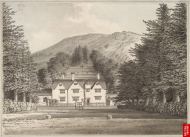The Fernhurst Society
Fernhurst history
Click on any image to see a larger version (note: the larger images may take a minute to download over slow internet connections).
The village of Fernhurst to the year 2000 AD
The following text is reproduced from the reverse of the Society's Millennium map:
FERNHURST, with a population of some 2000 people is a thriving community of houses, shops and businesses centred upon The Cross and the Village Green. It is a typical West Sussex village, evolving over nearly a thousand years to meet the needs of its inhabitants, with its roots in an ancient past.
Fernhurst lies on the borders of the great, once-forested, Weald in a thickly-wooded clay-floored valley between the sand topped ridges of Blackdown and Marley to the north and Henley and Bexley to the south. The little river Lod, tributary of the western Rother, drains the area.
From flint arrowheads to under-floor heating
Our story begins at the end of the last Ice Age, when the Stone Age hunter-gatherers began to clear the Wealden forests, using knapped flint tools brought from the South Downs. These have been found in the hills (Moses Hill on Marley) and in the valley (Sollers and Surney). Little evidence remains for the Bronze and Iron Ages here, but the Romans used the local clay, timber and water found at Surney for a factory producing roof, floor and hypocaust (under-floor central heating) tiles.
The Dark Ages to the Crusades
Four hundred years of Roman domination had ended by the 5th century A.D. During the next five hundred the clearing of the forests continued, with timber-felling and charcoal burning, and swineherds from the south bringing their pigs for seasonal pasturage among the oak and beach. None of this has left evidence, and the Domesday book of 1087 ignores the scattered populations of the Weald. Our Saxon predecessors named the area 'fearn hyrst' meaning 'ferny wooded hill', and settlement spread gradually from isolated farmsteads in clearings. By the 12th century small farms linked by paths centred upon the new stone church, dedicated to St Margaret of Antioch -- the Crusaders' favourite saint -- and probably built as a soldier's thank offering for safe return from the Middle East.
15th century -- Hall-houses and Noxious Fumes
Until the last century, traces of a 14th century fortified hunting tower, Verdley Castle, could be seen in Henley Woods, but less solid farm and forest dwellings had long since disappeared. In Fernhurst the earliest surviving buildings are 'hall-houses' dating from the 15th century: timber-framed, in-filled with wattle-and-daub or, later, by locally made bricks. Examples of these are the yeoman farmers' Moses Hill and Home Farm (Oeborne), while Sollers, on The Green, may have housed the saddlery. Beyond the village lay the Tanyard. The Tannery needed oak bark and running water provided by the location -- and the village was protected from the noxious fumes produced by curing hides.
There are many houses still inhabited which were built in the 16th and 17th centuries, including Chase, Dawes, North Park and Lower House farms, together with the Reeks Reynolds (Timberscombe), Popmoor, Vanlands, Bridgelands, Courts Farm and Baldwyns.
Early 17th century -- Cast-iron and Canon from a mini 'Black Country'
It is hard to associate a densely-wooded area such as Fernhurst with heavy industry, yet that was a situation for long periods over two centuries, periods of clamour and bustle with the thick pall of industrial smog hanging over the valley. Using the large natural iron deposits, streams, and charcoal from the surrounding woods, a skilled workforce produced cast-iron cannon and farming and domestic implements. This industrial past is recalled by the names; Minepit Copse, Furnace Pond, Furnace Wood and The Barracks (home to some of the imported workers). There is evidence of a dam at Surney, with a dam, sluices and piles of slag at North Park.
Friday's Hill may have been named from the muddy day-long haul of cannon from the valley -- and Saturday's Nap from the rest at the top.
Mid-17th century -- Civil War, ambush and an executioner's 'safe house'
As in feudal times, the lack of a major local land-owner had one advantage for the men of Fernhurst. Unlike their southern neighbours they were not called up to fight at home or abroad. However the copse name of Cavalry Quarters may come from a Royalist troop of the Civil War (1642-51). Local legend tells of ambush failing when Parliamentarian soldiers chose another route through the valley.
The Cavaliers might have been more successful had they lain in wait for Oliver Cromwell at Blackdown House, home of ironmaster William Yaldwyn, (Yalden), whom he visited occasionally. It is said that on one of these occasions Cromwell negotiated a 'safe house' nearby for the executioner of King Charles I.
During Cromwell's Protectorate the staunchly Royalist rector of Fernhurst was ejected from the parish by a more conforming parson, only returning with the restoration of Charles II in 1660.
A watercolour view of
Mr Yalding's house on Black Down near Fernhurst in West Sussex built in
1640 drawn on May 27th 1790 by Samuel Hieronymus Grimm
(image courtesy of the British Library, reproduced with permission)
18th century -- Turnpikes and Tolls
By 1777 Fernhurst, last of the iron foundries of West Sussex, had had its industrial heyday, superseded by the invention elsewhere of coke-fuelled processes. Woodland management, forestry and farming once more absorbed the valley. The gentrification of yeoman houses such as North Park, The White House and Chase Farm reflect the affluence of these times.
A fortunate legacy of the 'iron age' was an improvement in the roads, the 'Fernhurst clay' previously having made it notoriously difficult to get in or out of the village. 1749 saw the establishment of the Sussex Turnpike Trust to maintain the road from Hindhead Heath to Chichester. This included Fernhurst Lane and formed the basis of our present roads and village expansion around The Cross, with a toll-gate at Kingsley Marsh (now Green) -- which regulars became adept at dodging.
19th-century -- the railway, incomers and... philosophy
The opening of Haslemere station on the London to Portsmouth line in 1859 made Fernhurst far more accessible to the outside world. New building from The Cross along the Midhurst and Vann (Chapel Street) roads, as well as larger establishments in the countryside, provided homes for people who worked elsewhere.
The surrounding hills became popular with professional people and intellectuals -- artists, scientists, writers and thinkers, for both holiday homes and permanent residences. Anthony Salvin, the eminent architect, was an early 'incomer'. Building Hawksfold for himself, he designed Verdley Place in 1870 and worked on the restoration of Petworth and Blackdown houses. He left little of the original medieval structure when remodelling St Margaret's church.
The Pearsall-Smith family, American Quakers, took Friday's Hill House. Their son Logan rented Highbuilding. Whilst their daughter Alys married Bertrand Russell, and lived in the Vann Bridge Cottage (now Vann Bridge Close) and Millhanger, which became the meeting place for other noted philosophers. Alys's niece Ray married into the writer Lytton Strachey's family and built the Mud House helped by her friends.
Over the years Fernhurst has had many benefactors, as recorded in the Parish Magazines. The Schusters of Verdley, the Phillipson Stowes of Blackdown, the Ohlenschlagers, Hollists, Dickinsons and Dukes all contributed to the wide-ranging activities of a thriving community. Owen Scripps Tudor leased the site for the Village Hall in 1909 for an annual 'pepper corn' sum of 5/- (25p), still paid every year to this day. Nearby he built and endowed the non-denominational Almshouses, the Hostel Of The Good Shepherd administered for many years by his daughters.
20th-century -- War, sacrifice, renewal and exciting new prospects
Fernhurst sent its men to both World Wars, and the names of those who gave their lives are publicly recalled each Remembrance Day. In the Great War the 9th Gordon Highlanders were quartered at Highbuilding and elsewhere in the village. While in World War II, territorials camped at Highfield during the D-Day planning, with American troops also under canvas on nearby Henley Common. The Cross was bombed in 1941, and two years later one of the Luftwaffe's Dorniers were shot down in Reeks Wood. Amazingly, its bomb load remained intact and was only recovered and the explosive steamed out in 1989.
Not all the incomers during this dark time were soldiers. Children evacuated from Portsmouth and London were billetted locally and attended school on The Green and at Ropes.
The shared experience of war further united the village and the sense of community was expressed in a range of amenities and social organisations. The traditional May Queen ceremony was revived in the 1920s and is still a part of today's Fernhurst Revels. The Grand Coronation Pageant of 1953 was filmed in colour and now forms part of the village archive.
The sad chapter in the village's recent history was the tragedy of November 1967 when an Iberian Airways Caravelle passenger jet crashed on Blackdown. There were no survivors. Shocked by the terrible loss of life, the villagers nevertheless rallied to help the bereaved relatives and provide support for the emergency services.
In 1945 the Verdley Estate was sold to Plant Protection Limited which became the Plant Protection Division of I.C.I., employing many people locally. Over the years research and development work was relocated and in 1993 I.C.I. Agrochemicals became Zeneca Agrochemicals. This business now operates from an office complex and conference centre at Highfield. Throughout all these changes the Company has been appreciated as a willing supporter of village projects.
Although the traditional forestry and farming have sharply declined since the war, Fernhurst's population has continued to grow. The roads, rail and now the Internet have ended the village's long isolation. New houses are being built, new incomers are being welcomed and this long-established community looks set to complement its interesting past with an exciting future.
© The Fernhurst Society.
Published on 1st July 2000 as part of the West Sussex millennium parish maps project.
Fernhurst History


